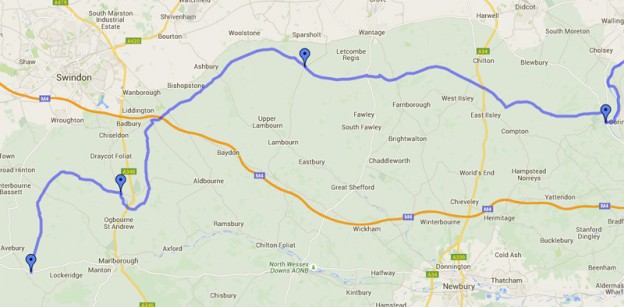At our September 2015 meeting Russell Cherry, keen historian, walker and photographer took us on a photographic journey along a portion of the Ridgeway Path – an ancient trackway described as Britain’s oldest road used for over 5000 years. The journey, taken by Mr Cherry in 2004, covered many of the historical sites and points of interest along the way (with small diversions to local pubs!). The route follows the high chalk uplands which made travel easy and provided a measure of protection offering a commanding view over the countryside.
The journey started at Avebury in Wiltshire, a well known Neolithic stone circle and continued to other Neolithic sites including Silbury Hill, West Kennet Long Barrow and along the West Kennett Avenue, a stone-marked processional way to The Sanctuary – originally a circle of timber posts from approximately 3000BC.
We then proceeded past Overton Hill with bronze age round barrows and on to the unusual dolmen (burial chamber) called The Devil’s Den and then onto another white horse chalk figure at Hackpen Hill. This was created in 1838 to commemorate the coronation of Queen Victoria in 1838. Not far from Hackpen Hill is Barbury Castle, an Iron Age hill fort with its deep defensive ditches – the route crossed directly through the castle.
Less than 5 miles from Barbury Castle is Liddington Castle, a late Bronze/early Iron Age hillfort. At this point we crossed over the M4 and made a short diversion to Alfred’s Castle, a small Iron Age hillfort near to Ashdown Park – associated with the Battle of Ashdown (AD 871) where King Alfred won a great victory against the Danes.
We then reached an area perhaps more well-known to most of us – Wayland’s Smithy, an impressive Neolithic Long Barrow once believed to have been the habitation of the Saxon smith-god Wayland – and White Horse Hill, Uffington Castle and Dragon Hill. Nearby, and perhaps a little less known is the monument commemorating Lord Wantage, Robert Loyd Lindsay. Lindsay was awarded the Victoria Cross during the Crimean War and was one of the founders of the Red Cross. He donated the Victoria Gallery building in Wantage (now a set of shops) and the statue of King Alfred in the market square.
Moving Eastwards, within a small woodland adjacent to the Ridgeway path, stands Scutchamer Knob. It is a raised earth mound and legend has it, that it is the burial mound of the Saxon king Cwichelm.
Finally, we completed our photographic tour of this section of the Ridgeway reaching Streatley, next to the River Thames. Our visit would not be complete without a final visit to a pub, The Bull where, in 1440, a monk and a nun were executed for “misconduct” – they are buried in the garden.
The History Society would like to thank Mr Cherry for his entertaining and informative talk.

